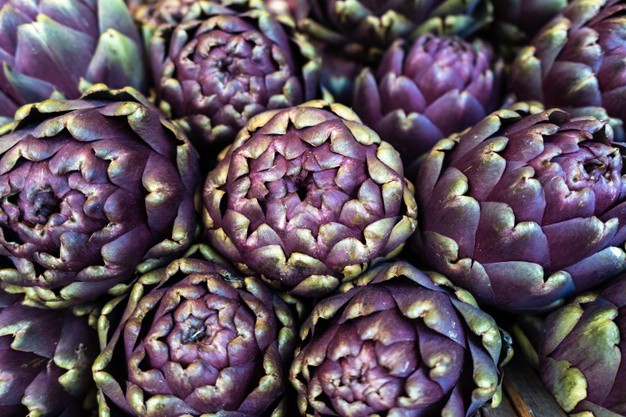
Anistatia Miller and Jared Brown make the most of an overabundance of nuts and artichokes with homemade versions of some classics.
Ever wish a particular ingredient was less sweet? It’s one of the triggers that set us on a quest to make proprietary versions of harvest/market liqueurs and amaros. Our latest thoughts have turned outdoors as we stroll past an absolute glut of globe artichokes that have popped up despite the ceaseless rain of spring 2019.
Past the artichokes, we turn a corner toward the green, olive-shaped drupes (immature nuts) that have sprouted on our walnut trees. And finally, we meander across the lawn to inspect the cob and corkscrew hazel trees.
What does this mean in drink-think? Time to make home versions of Cynar, Nocino, and Frangelico.
Without a pair of leather gardening gloves, peeling raw artichoke leaves becomes a metaphor for bloodletting, so get the gloves on first or snip those spikes off with a pair of scissors. Ten uncooked artichoke leaves go into a 1-litre clip-top jar with grated orange zest. Add as much zest as you like.
Traditionally, Cynar is made on a grappa base, but if you prefer a lighter touch, you can try using a grape or grain-based vodka as your primary liquid. Steep for four to six weeks – remember, all maceration times have a flavour bell curve, and overly-long is rarely better than correct timing. During the maceration, test and adjust your citrus balance weekly with more zest. Strain the liquid into a jug and add a little sweetness. Here, you can go one of three ways: add a tablespoon of brown sugar; add the treacly nose of dark muscovado sugar; or go straight to the deep, spicy goodness of dark treacle. Be sure to add a little at a time and taste as you go. When you hit your desired sweetness level or a bit under it, stir well and pour into a bottle and seal. Allow your cynar to mature for at least a month to allow the flavours to harmonise.
Making Nocino is a little more complicated. Gather 25 green walnuts as soon as they are walnut-sized. Though tradition dictates you must gather them overnight between June 23 and 24 to keep the witches from stealing them, you can simply order them online from places such as the Potash Farm shop (kentishcobnuts.com). If you are harvesting them yourself, don’t wait or the squirrels (the real witches in this Grimm tale) will harvest them. To process green walnuts, don a pair of washing-up gloves – Marigolds work a treat – and quarter them lengthwise with a very sharp knife. Plop the quarters into a 2-litre clip-top jar along with a cinnamon stick, half of a nutmeg that has been scraped a little with a rasp, the grated zest of a whole lemon, three whole cloves, and 10 espresso coffee beans. Pour a litre of vodka or grappa over the contents and steep for four to six weeks. Sweeten with either simple syrup or a 1:1 syrup of dark muscovado to taste. We prefer ours a little less sweet and a lot more spicy and nutty.
By contrast, our take on Frangelico gathers its nuttiness by steeping 225g of shelled, unskinned, roughly chopped hazel or cobnuts with a litre of a 1:1 blend of vodka and cognac in a 2-litre clip-top jar. Add a split vanilla bean for a touch of decadence and steep for four to six weeks. Strain and sweeten with either simple or muscovado syrup to taste.
These recipes will give you healthy practise before we hit the late harvest and prepping for some winter-time treats.
ARTICHOKE
Cynara cardunculus are large, architectural perennials with grey-green leaves, grown for their large, edible flower buds but ornamental enough for the flower garden. These green, scaly buds open to thistle-like purple flowers in summer and autumn.
Sunlight: Full sun
Aspect: South-facing, east-facing or west-facing
Exposure: Sheltered
Moisture: Well-drained
Soil: Loam, chalk, sand
PH: Acid, alkaline, neutral
WALNUT
Juglans regia is a medium-sized, broad-crowned deciduous tree. Leaves with five to seven large oblong leaflets, aromatic when bruised. Male catkins to 10cm in length; fruits green, globose, 5cm in width, with edible kernel.
Sunlight: Full sun
Aspect: North-facing, east-facing, south- facing or west-facing
Exposure: Sheltered or exposed Moisture: Moist but well-drained
Soil: Chalk, clay, sand, loam
PH: Acid, alkaline, neutral
HAZEL
Corylus avellana is a large, spreading deciduous shrub or small tree, with rounded leaves turning yellow in autumn, and yellow male catkins in early spring, followed by edible nuts in autumn.
Sunlight: Full or partial sun Aspect: South-facing, north-facing, west-facing or east-facing Exposure: Exposed or sheltered Moisture: Moist but well-drained Soil: Loam, chalk, sand
PH: Alkaline, neutral

